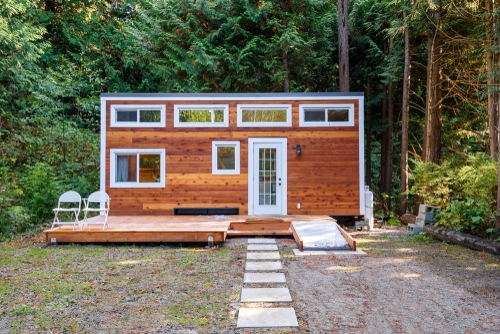
Tiny Homes in Guelph: What You Need to Know About ARDUs (Additional Residential Dwelling Units)
Tiny homes have gained considerable attention in recent years, particularly as municipalities like the City of Guelph and the Province of Ontario push for greater housing density. With increasing immigration, rising home prices, and changing lifestyle preferences, these homes—also known as ARDUs (Additional Residential Dwelling Units)—have become an innovative solution to address the housing crisis.
In this blog, we’ll explore what tiny homes are, why they matter, what makes them appealing, and how they fit into the regulatory framework of Guelph.
Jump Links:
- What is a Tiny Home?
- Why All the Interest?
- Why Are Tiny Homes Encouraged?
- What’s the Appeal?
- How Much Does a Tiny Home Cost?
- Considerations
- How Do I Build a Tiny Home in Guelph?
- Financing and Grants
What is a Tiny Home?
A tiny home is a small, private, self-contained dwelling—typically between 100 and 600 square feet—with essential amenities for year-round living. It includes a kitchen, bathroom, living area, and sleeping quarters. It may be standalone or attached to an existing home (e.g., garage suite or garden suite).
Why All the Interest in Tiny Homes?
The Ontario Homes Built Faster Act aims to add 1.5 million new homes across the province over the next decade. As part of this effort, Guelph is committed to creating 18,000 new housing units by 2031.
To meet this goal, the City of Guelph is:
- Streamlining its development approvals process
- Enhancing staff resources for infrastructure projects (water, wastewater)
- Ending exclusionary zoning to allow triplexes and ARDUs in traditionally single-family zones
- Encouraging gentle residential infill instead of outward sprawl
These changes create a fertile environment for smaller homes and other forms of intensification.
Why Are Tiny Homes Encouraged?
Until recently, Guelph only allowed up to two units (e.g., duplex or ARDU) on a residential lot. Now, policies are being relaxed to allow for three or more units—especially on larger city lots.
Consider midtown Guelph neighbourhoods like Exhibition Park or St. George’s Park. Many 1950s bungalows here sit on 50’ x 100’ lots, offering ample space for a tiny home in the backyard.
This type of gentle density:
- Makes efficient use of urban land
- Reduces the cost of homeownership
- Supports multigenerational living or rental income
What’s the Appeal anyways?
This format of home is gaining momentum for several reasons:
- Affordability – With the average Guelph detached home now over $900,000, tiny homes offer an affordable alternative.
- Sustainability – Smaller footprints mean less energy consumption and waste.
- Low Maintenance – Fewer rooms to clean and minimal outdoor upkeep.
- Flexible Use – Ideal for downsizing, student housing, guest suites, or short-term rentals like AirBnB.
How Much Does a Home Like This Cost?
These types of homes in Ontario generally range from $40,000 to $150,000, but several factors affect pricing:
- Size – Staying under 600 sq ft lowers costs and meets local zoning rules.
- Materials & Finishes – Custom hardwoods or quartz countertops can raise your budget significantly.
- Prefab vs. On-Site – Prefab homes can be built year-round offsite but require transport. On-site builds avoid that cost but are subject to weather delays.
Things you need to consider:
Here are key questions to ask:
- Usage – Will it be a rental, AirBnB, or your primary residence?
- Mobility – Is it on wheels or a permanent foundation?
- Layout – Custom vs. standard floorplans affect both livability and cost.
- Compliance – Ensure it meets Guelph’s building code and zoning regulations.
- Services – How will water, sewer, and hydro connect to the existing home?
How Do I Build This Type of Home in Guelph?
The City of Guelph has rules for building additional residential units. Here’s a simplified guide for detached ARDUs:
- Max size: 80 sq m (861 sq ft), or 45% of the gross floor area of the primary home
- Max bedrooms: Two
- Yard coverage: Cannot exceed 30% of total yard area (including other structures)
- Max height: 5 m (or 6.1 m if above a garage), and cannot exceed the height of the main home
Different rules apply for internal ARDUs (e.g., basement suites). See the City’s ARDU guidelines for full details.
Financing and Grants
Financing smaller homes can be tricky as many banks don’t offer standard mortgages on smaller, mobile, or non-traditional structures. Since this is a relatively new angle on real estate development, lenders haven’t yet fully embraced them.
However, options include:
- Home equity lines of credit (HELOC) on your primary residence
- Private lenders or tiny home-specific financing programs
- CMHC programs such as the Canada Greener Homes Grant, if your tiny home meets energy efficiency standards
- Municipal rebates for low-impact development (e.g., permeable surfaces, rainwater systems)
Check with a mortgage broker or your lender for the best path forward. Also, remember that these type of homes aren’t always a separate building. They could be attached to the existing structure or above a garage. Alternatively, they could even be a basement unit. This is important information for your lender.
Have more questions?
If you’re considering this type of home in Guelph, give Beth and Ryan Waller, trusted Guelph real estate agents, a call. We’ll help you navigate zoning regulations, builder options, and investment potential.
📞 519-546-3390
🌐 bethandryan.ca